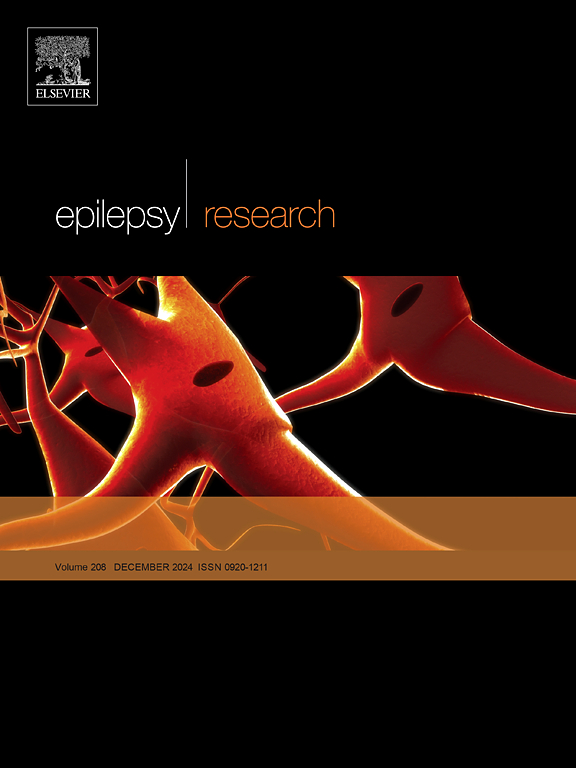Thrombin mediates seizures following cortical injury-induced status epilepticus
IF 2
4区 医学
Q3 CLINICAL NEUROLOGY
引用次数: 0
Abstract
The neurobiological mechanisms underlying acute seizures, status epilepticus (SE), and cerebral edema following cortical insult are unknown. Currently, benzodiazepines are first-line therapy for SE, and mechanistic insight could lead to improved treatment for cortical-injury-related seizures. Cobalt was implanted in the supplementary motor cortex (M2). Homocysteine was administered sixteen hours later, which converted focal seizures to SE. Seizures were monitored by video-EEG. Blood-brain barrier (BBB) damage was assessed using Evans blue staining and Western blotting. Cerebral edema was evaluated using MRI and a wet-dry method of measuring brain water content. We also assessed if diazepam and thrombin inhibitor α-naphthylsulphonylglycyl-4-amidinophenylalanine piperidine (α-NAPAP) administered individually or together treated seizures and protected animals from edema and mortality. Blood proteins thrombin and albumin were present in the brain parenchyma, primarily in the ipsilateral hemisphere, of animals in SE. Evans blue staining revealed a wider spread of albumin in post-SE animals compared to those in early SE. The seizures rapidly became diazepam-resistant, and the drug did not reduce death due to cerebral edema. Thrombin inhibitor α-NAPAP reduced cerebral edema and prevented seizures. A combination of diazepam and α-NAPAP treatment suppressed seizures, lowered edema, and improved survival. Thrombin extravasation triggers seizures and edema following neocortical injury, and it is a therapeutic target. A combination of benzodiazepines and anti-thrombin agents could terminate SE and reduce mortality.
凝血酶介导皮层损伤引起的癫痫持续状态后的癫痫发作
皮层损伤后急性发作、癫痫持续状态(SE)和脑水肿的神经生物学机制尚不清楚。目前,苯二氮卓类药物是SE的一线治疗药物,对其机制的了解可能会改善皮质损伤相关癫痫发作的治疗。钴植入辅助运动皮质(M2)。16小时后给予同型半胱氨酸,将局灶性癫痫转变为SE。通过视频脑电图监测癫痫发作情况。采用Evans蓝染色和Western blotting检测血脑屏障(BBB)损伤情况。采用MRI和干湿法测量脑含水量评估脑水肿。我们还评估了地西泮和凝血酶抑制剂α-萘基磺酰甘酰基-4-氨基苯丙氨酸哌啶(α-NAPAP)单独或联合使用是否能治疗癫痫发作,并保护动物免受水肿和死亡。血凝血酶和白蛋白主要存在于SE动物的同侧半球脑实质中。Evans蓝色染色显示,与早期SE相比,SE后动物的白蛋白分布更广。癫痫发作迅速对安定产生耐药性,而且这种药物并没有减少脑水肿造成的死亡。凝血酶抑制剂α-NAPAP减少脑水肿,预防癫痫发作。地西泮联合α-NAPAP治疗可抑制癫痫发作,降低水肿,提高生存率。凝血酶外渗引起新皮质损伤后的癫痫发作和水肿,是一个治疗靶点。苯二氮卓类药物联合抗凝血酶药物可终止SE,降低死亡率。
本文章由计算机程序翻译,如有差异,请以英文原文为准。
求助全文
约1分钟内获得全文
求助全文
来源期刊

Epilepsy Research
医学-临床神经学
CiteScore
0.10
自引率
4.50%
发文量
143
审稿时长
62 days
期刊介绍:
Epilepsy Research provides for publication of high quality articles in both basic and clinical epilepsy research, with a special emphasis on translational research that ultimately relates to epilepsy as a human condition. The journal is intended to provide a forum for reporting the best and most rigorous epilepsy research from all disciplines ranging from biophysics and molecular biology to epidemiological and psychosocial research. As such the journal will publish original papers relevant to epilepsy from any scientific discipline and also studies of a multidisciplinary nature. Clinical and experimental research papers adopting fresh conceptual approaches to the study of epilepsy and its treatment are encouraged. The overriding criteria for publication are novelty, significant clinical or experimental relevance, and interest to a multidisciplinary audience in the broad arena of epilepsy. Review articles focused on any topic of epilepsy research will also be considered, but only if they present an exceptionally clear synthesis of current knowledge and future directions of a research area, based on a critical assessment of the available data or on hypotheses that are likely to stimulate more critical thinking and further advances in an area of epilepsy research.
 求助内容:
求助内容: 应助结果提醒方式:
应助结果提醒方式:


